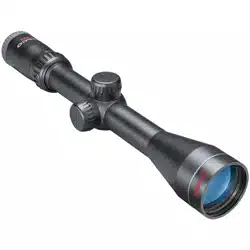Loading ...
Loading ...
Loading ...

5
PRELIMINARY SIGHTING-IN
You can save a significant amount of expense and frustration by pre-sighting the scope to the rifle before you take it to the
range for zeroing.
There are two basic methods that can be used for pre-sighting your scope. Method one is to use a Bushnell® Bore Sighter
(laser, magnetic or standard). The use of a Bore Sighter saves time and ammunition and is the system most often used by
gunsmiths. Follow the directions supplied with your boresighter. The second method is traditional bore sighting:
BORE SIGHTING METHOD
1. Place a target at 25 to 50 yards.
2. Remove the bolt from the rifle.
3. Place the rifle on sandbags or a shooting rest.
4. Set the scope to its lowest magnification.
5. Peer through the bore from the receiver and adjust the position of the rifle to center the target bull’s eye in the bore (Fig.
A).
6. Without moving the rifle, look into the scope and note the position of the reticle on the target. Adjust the windage and
elevation adjustments to center the reticle on the bull’s eye (Fig. B).
FINAL SIGHTING-IN
WARNING: SINCE THIS PROCEDURE INVOLVES LIVE FIRE, IT SHOULD BE DONE AT AN APPROVED RANGE OR
OTHER SAFE AREA. CHECK BORE FOR OBSTRUCTIONS. AN OBSTRUCTED BORE MAY CAUSE INJURY TO YOU
AND OTHERS NEARBY. EYE AND EAR PROTECTION IS RECOMMENDED.
1. From a steady rest position, fire two or three rounds at a 50-yard target. Note the impact of the bullet on the target and
adjust the windage and elevation dials as needed.
2. To move the bullet impact, turn the windage and/or elevation adjustments in the direction on the dials that corresponds to
where the impact point falls on the target (for example, if test shots are hitting low, adjust elevation “down”). The adjustments
on your riflescope model are marked in MOA (minutes of arc), and the point of impact at 100 yards will change by 1/4” for
each click of the windage or elevation adjustment. One full revolution of the adjustment=15 MOA.
3. When the impact on the 50-yard target is satisfactory, switch to a target set at the desired distance for final zeroing. Set the
magnification to the desired power on variable power models.
ALTITUDE AND TEMPERATURE
Ballistic charts published by ammunition manufacturers are based upon standard sea level conditions. When sighting in, it is
well to keep in mind that altitude and temperature affect trajectory. It is best to sight-in under the same conditions in which
you will be hunting.
CARING FOR YOUR RIFLESCOPE
Your scope needs very little maintenance. Exterior metal surfaces should be kept clean. A light dusting with a slightly
dampened soft cloth is enough in most cases.
Your new scope features windage and elevation turrets that are completely sealed against water intrusion. However, we
recommend that you keep the windage and elevation caps on the turrets, except when making adjustments, to prevent dust
and dirt from collecting in the turret area.
We also recommend that lens covers be kept in place when the scope is not being used. Lenses should be inspected regularly
and kept clean at all times. Dust, dirt, and fingerprints that collect on the lens surfaces will severely degrade image quality, and
if left unclean for long periods, the anti-reflection coating could be damaged. Although lens cleaning is not difficult, it does
require care and some patience.
• Start with a lens brush or a small, soft bristle paintbrush. Gently whisk away loose dirt particles.
Fig. A
Reticle not in alignment
Fig. B
Reticle in alignment
Loading ...
Loading ...
Loading ...
